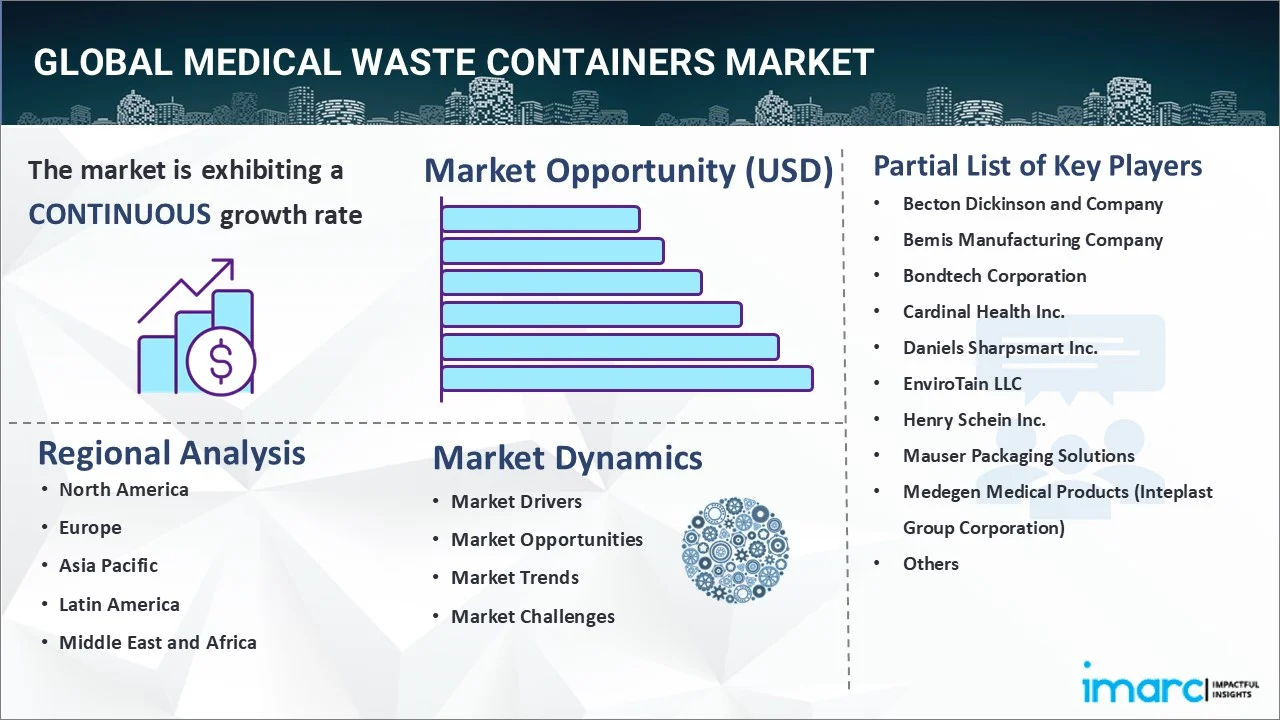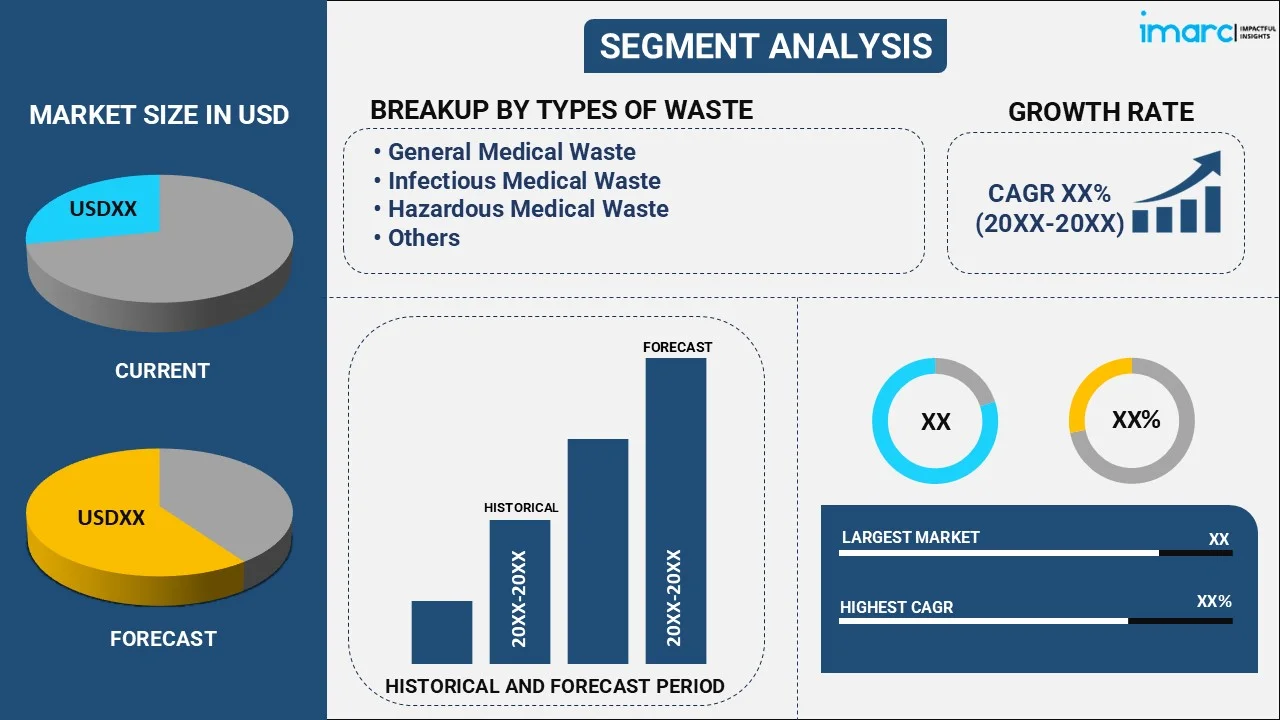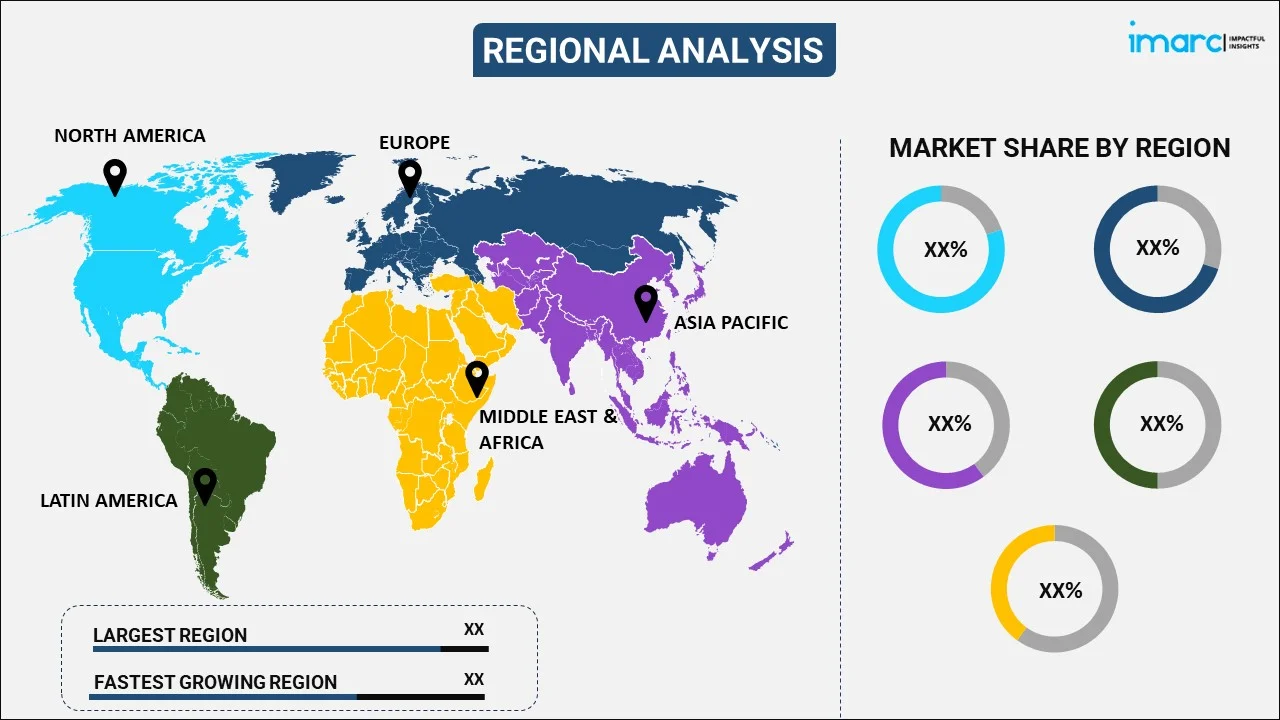
Medical Waste Containers Market Report by Type of Waste (General Medical Waste, Infectious Medical Waste, Hazardous Medical Waste, Radioactive Medical Waste, and Others), Product (Chemotherapy Containers, Biohazardous Medical Waste Containers, Sharps Medical Waste Containers, Resource Conservation and Recovery Act (RCRA) Containers, and Others), End User (Hospitals and Private Clinics, Pharmaceutical and Biotechnology Companies and CROs, Academic Research Institutes, Diagnostic Laboratories, and Others), and Region 2025-2033
Market Overview:
The global medical waste containers market size reached USD 2,486 Million in 2024. Looking forward, IMARC Group expects the market to reach USD 3,950.2 Million by 2033, exhibiting a growth rate (CAGR) of 5.3% during 2025-2033. The rising prevalence of various acute and chronic health conditions, increasing medical tourism, and the expansion of hospitals, clinics, and other healthcare settings are some of the major factors propelling the market.
|
Report Attribute
|
Key Statistics
|
|---|---|
|
Base Year
|
2024
|
|
Forecast Years
|
2025-2033
|
|
Historical Years
|
2019-2024
|
|
Market Size in 2024
|
USD 2,486 Million |
|
Market Forecast in 2033
|
USD 3,950.2 Million |
| Market Growth Rate 2025-2033 | 5.3% |
Medical waste containers are used for containing, storing, transporting, and disposing various types of medical waste, including sharps, infectious materials, pharmaceuticals, and pathological waste. They help minimize the risk of infection and prevent the spread of diseases. They are made from leak-proof seals, puncture-resistant materials, and secure closures to prevent any accidental spills or releases of hazardous waste. Besides this, they aid in preventing infections, ensuring worker safety, promoting waste segregation, and contributing to environmental sustainability. Moreover, waste containers provide a safe and secure way to handle and store hazardous waste, thereby preventing accidental injuries, such as needlesticks.

The growing awareness about the hazards of improper waste management among healthcare workers and the general public is driving the demand for medical waste containers. Educational campaigns conducted by health organizations and governments are reinforcing the importance of using proper waste containers for different types of medical waste. Furthermore, technological developments in the design and manufacturing of medical waste containers are contributing to market growth. These advancements include biohazardous waste containers that change color when full, or containers with inbuilt needle removal ports, which enhance user safety and convenience. Moreover, with the growing pharmaceutical industry, the waste generated from expired or unused medications is rising. This is increasing the need for safe disposal solutions like medical waste containers.
Medical Waste Containers Market Trends/Drivers:
Rise in the cases of hospital-acquired infections (HAIs)
The increasing prevalence of several hospital-acquired infections, such as surgical site infections, urinary tract infections, bloodstream infections, and pneumonia among healthcare professionals and patients is favoring market growth. Additionally, the rising prevalence of various chronic disorders, prolonged hospital stays, and the increasing utilization of invasive medical devices increase the exposure and vulnerability to pathogens, contributing to the rise in HAIs. There is a rise in global travel and healthcare tourism which is leading to the spread of infections across borders and escalating the need for effective medical waste containers. Furthermore, the increasing use of antibiotics in healthcare settings is contributing to the development of drug-resistant strains of bacteria and increasing the risk of HAIs, which, in turn, is propelling the demand for advanced medical waste containers.
Stringent waste management regulations
Stringent regulations and guidelines set by government bodies and regulatory agencies worldwide drive the demand for compliant medical waste containers. These regulations, such as those by the U.S. Environmental Protection Agency (EPA) and Occupational Safety and Health Administration (OSHA), enforce strict protocols for medical waste handling, containment, transportation, and disposal. Healthcare facilities must comply with these regulations, creating a need for appropriate containers to ensure safe and compliant waste management practices. The governing authorities are also focusing on infection control measures which are driving the demand for high-quality medical waste containers that can effectively isolate potentially infectious waste to minimize the risks associated with medical waste, protect public health, and maintain environmental sustainability. The governing authorities of various countries are implementing protocols for the handling and disposal of specific types of medical waste.
Expansion of Healthcare Settings
The rising number of healthcare facilities, including hospitals, clinics, and diagnostic centers, is one of the major factors driving the demand for the medical waste container across the globe. As the healthcare infrastructure expands, the volume of medical waste generated increases proportionally, necessitating proper waste management solutions and specialized containers. The growing global population, coupled with an aging population, and the rising prevalence of various chronic health conditions, road accidents, and sports injuries create a higher demand for healthcare services. As the population increases, the need for healthcare facilities and services expands, leading to the establishment of new healthcare settings or the expansion of existing ones. Furthermore, increasing investments by the governing authorities of the countries of developing economies to improve their healthcare infrastructure is contributing to market growth.
Medical Waste Containers Industry Segmentation:
IMARC Group provides an analysis of the key trends in each segment of the global medical waste containers market report, along with forecasts at the global, regional and country levels from 2025-2033. Our report has categorized the market based on type of waste, product and end user.
Breakup by Type of Waste:

- General Medical Waste
- Infectious Medical Waste
- Hazardous Medical Waste
- Radioactive Medical Waste
- Others
General medical waste dominates the market
The report has provided a detailed breakup and analysis of the market based on the type of waste. This includes general medical waste, infectious medical waste, hazardous medical waste, radioactive medical waste, and others. General medical waste represented the largest segment.
General medical waste refers to the non-hazardous waste generated in healthcare facilities, including hospitals, clinics, and laboratories. This category of waste encompasses items, such as gloves, gowns, bandages, packaging materials, and non-infectious patient bedding. Although general medical waste is not considered highly hazardous, it still requires proper management due to the potential risks it poses to public health and the environment. Medical facilities must adhere to specific guidelines and regulations for the safe collection, segregation, storage, transportation, and disposal of general medical waste. By employing appropriate containers and following established protocols, healthcare providers can ensure the efficient and secure handling of general medical waste, contributing to the overall safety and sustainability of their operations.
Breakup by Product:
- Chemotherapy Containers
- Biohazardous Medical Waste Containers
- Sharps Medical Waste Containers
- Resource Conservation and Recovery Act (RCRA) Containers
- Others
Chemotherapy containers hold the largest share in the market
A detailed breakup and analysis of the market based on the product has also been provided in the report. This includes chemotherapy containers, biohazardous medical waste containers, sharps medical waste containers, resource conservation and recovery act (RCRA) containers, and others. According to the report, chemotherapy containers accounted for the largest market share.
Chemotherapy containers are specifically designed to meet the unique requirements of chemotherapy waste, which consists of drugs and materials that can be harmful to human health and the environment. Regulatory bodies and environmental agencies are implementing strict guidelines and regulations for the proper handling and disposal of chemotherapy waste to prevent the spread of infection. Besides this, these containers provide an added layer of protection by minimizing the risk of exposure to hazardous drugs, reducing the potential health risks for staff. Furthermore, the leading market players are focusing on improving chemotherapy container designs to enhance their functionality and safety features. These advancements include leak-proof seals, tamper-evident closures, and color-coded labeling for easy identification. Additionally, the availability of more efficient and user-friendly chemotherapy containers is contributing to their increased adoption.
Breakup by End User:
- Hospitals and Private Clinics
- Pharmaceutical and Biotechnology Companies and CROs
- Academic Research Institutes
- Diagnostic Laboratories
- Others
Hospitals and private clinics hold the largest market share
A detailed breakup and analysis of the market based on the end user has also been provided in the report. This includes hospitals and private clinics, pharmaceutical and biotechnological companies and CROs, academic research institutes, diagnostic laboratories, and others. According to the report, hospitals and private clinics accounted for the largest market share.
The rising prevalence of hospital-acquired infections (HAIs) is catalyzing the demand for medical waste containers in hospitals and private clinics. Additionally, the expansion of hospitals and private clinics across the globe is propelling the adoption of medical waste containers. Apart from this, healthcare facilities are focusing on proper waste management to prevent the spread of infections and diseases by using secure and reliable medical waste containers to maintain a safe and clean healthcare environment. Furthermore, governments of various countries are enforcing strict regulations concerning the disposal and management of medical waste and mandating the use of specified containers to segregate and store different types of waste.
Breakup by Region:

- North America
- United States
- Canada
- Asia-Pacific
- China
- Japan
- India
- South Korea
- Australia
- Indonesia
- Others
- Europe
- Germany
- France
- United Kingdom
- Italy
- Spain
- Russia
- Others
- Latin America
- Brazil
- Mexico
- Others
- Middle East and Africa
North America exhibits a clear dominance, accounting for the largest medical waste containers market share
The report has also provided a comprehensive analysis of all the major regional markets, which include North America (the United States and Canada); Asia Pacific (China, Japan, India, South Korea, Australia, Indonesia, and others); Europe (Germany, France, the United Kingdom, Italy, Spain, Russia, and others); Latin America (Brazil, Mexico, and others); and the Middle East and Africa.
North America held the biggest market share since the region has a well-established medical infrastructure. The region is home to numerous hospitals, clinics, and healthcare facilities that generate significant volumes of medical waste. Additionally, the aging population and increasing prevalence of chronic diseases, such as diabetes, cancer, and heart disease, is resulting in an increase in medical waste, which is driving the need for more medical waste containers. Strict regulations for the collection, transportation, and disposal of medical waste in North America act as a significant driver for this market. Regulations such as the Medical Waste Tracking Act and guidelines from Occupational Safety and Health Administration (OSHA) and Environmental Protection Agency (EPA) ensure compliance with waste segregation, which requires the use of appropriate medical waste containers.
Competitive Landscape:
Key market players are investing in research and development (R&D) activities to introduce products with advanced features, such as leak-proof seals, puncture resistance, odor control, and smart technologies. They are also focusing on strategic partnerships and mergers and acquisitions (M&A) to expand their product portfolio and market reach and enhance their capabilities. Collaborations with waste management service providers, healthcare facilities, and regulatory bodies help companies strengthen their position in the market and offer comprehensive waste management solutions. They are striving to meet the requirements set by regulatory bodies, such as the U.S. Food and Drug Administration (FDA) and various international health and safety standards. Several companies are actively engaged in obtaining certifications, such as UN packaging certifications, showcasing their commitment to quality, safety, and regulatory compliance.
The report has provided a comprehensive analysis of the competitive landscape in the market. Detailed profiles of all major companies have also been provided. Some of the key players in the market include:
- Becton Dickinson and Company
- Bemis Manufacturing Company
- Bondtech Corporation
- Cardinal Health Inc.
- Daniels Sharpsmart Inc.
- EnviroTain LLC
- Henry Schein Inc
- Mauser Packaging Solutions
- Medegen Medical Products (Inteplast Group Corporation)
- Stericycle Inc.
- Terra Universal Inc.
- Therma Fisher Scientific Inc.
Recent Developments:
- In May 2023, five organizations in Denmark, including Becton, Dickinson and Company, Odense University Hospital, the Health Innovation Centre of Southern Denmark, Danish Technological Institute, and GMAF Circular Medico/EcoFitt, are collaborating to evaluate the feasibility of recycling used blood collection tubes. The pilot program aims to reduce medical waste and align with Denmark's Climate Action Strategy.
- In January 2023, Thermo Fisher Scientific in Norway has developed a plastic-free technology, DynaGreen magnetic beads, which offers a more sustainable and eco-conscious solution for researchers in the field of life science.
- In 2022, Stericycle Inc.’s SafeShield™ Medical Waste Container has been awarded as the Product of the Year for its high-quality design, durability, and antimicrobial properties that combat the growth of microorganisms.
Medical Waste Containers Market Report Scope:
| Report Features | Details |
|---|---|
| Base Year of the Analysis | 2024 |
| Historical Period | 2019-2024 |
| Forecast Period | 2025-2033 |
| Units | Million USD |
| Scope of the Report | Exploration of Historical and Forecast Trends, Industry Catalysts and Challenges, Segment-Wise Historical and Predictive Market Assessment:
|
| Types of Waste Covered | General Medical Waste, Infectious Medical Waste, Hazardous Medical Waste, Radioactive Medical Waste, Others |
| Products Covered | Chemotherapy Containers, Biohazardous Medical Waste Containers, Sharps Medical Waste Containers, Resource Conservation and Recovery Act (RCRA) Containers, Others |
| End Users Covered | Hospitals And Private Clinics, Pharmaceutical And Biotechnology Companies and Cros, Academic Research Institutes, Diagnostic Laboratories, Others |
| Regions Covered | Asia Pacific, Europe, North America, Latin America, Middle East and Africa |
| Countries Covered | United States, Canada, Germany, France, United Kingdom, Italy, Spain, Russia, China, Japan, India, South Korea, Australia, Indonesia, Brazil, Mexico |
| Companies Covered | Becton Dickinson and Company, Bemis Manufacturing Company, Bondtech Corporation, Cardinal Health Inc., Daniels Sharpsmart Inc., EnviroTain LLC, Henry Schein Inc., Mauser Packaging Solutions, Medegen Medical Products (Inteplast Group Corporation), Stericycle Inc., Terra Universal Inc. and Thermo Fisher Scientific Inc. |
| Customization Scope | 10% Free Customization |
| Post-Sale Analyst Support | 10-12 Weeks |
| Delivery Format | PDF and Excel through Email (We can also provide the editable version of the report in PPT/Word format on special request) |
Key Benefits for Stakeholders:
- IMARC’s report offers a comprehensive quantitative analysis of various market segments, historical and current market trends, market forecasts, and dynamics of the medical waste containers market from 2019-2033.
- The research study provides the latest information on the market drivers, challenges, and opportunities in the global medical waste containers market.
- The study maps the leading, as well as the fastest-growing, regional markets. It further enables stakeholders to identify the key country-level markets within each region.
- Porter's five forces analysis assist stakeholders in assessing the impact of new entrants, competitive rivalry, supplier power, buyer power, and the threat of substitution. It helps stakeholders to analyze the level of competition within the medical waste containers industry and its attractiveness.
- Competitive landscape allows stakeholders to understand their competitive environment and provides an insight into the current positions of key players in the market.
Key Questions Answered in This Report
The global medical waste containers market was valued at USD 2,486 Million in 2024.
We expect the global medical waste containers market to exhibit a CAGR of 5.3% during 2025-2033.
The widespread applications of durable, chemical resistant, and puncture-proof medical waste containers in hospitals and veterinary clinics to prevent hospital-acquired infections, are primarily driving the global medical waste containers market.
The sudden outbreak of the COVID-19 pandemic has led to the growing utilization of medical waste containers across several hospitals and other healthcare facilities for curbing the spread of the coronavirus infection and its related health hazards.
Based on the type of waste, the global medical waste containers market can be categorized into general medical waste, infectious medical waste, hazardous medical waste, radioactive medical waste, and others. Currently, general medical waste exhibits clear dominance in the market.
Based on the product, the global medical waste containers market has been segmented into chemotherapy containers, biohazardous medical waste containers, sharps medical waste containers, Resource Conservation and Recovery Act (RCRA) containers, and others. Among these, chemotherapy containers represent the largest market share.
Based on the end user, the global medical waste containers market can be bifurcated into hospitals and private clinics, pharmaceutical and biotechnology companies and CROs, academic research institutes, diagnostic laboratories, and others. Currently, hospitals and private clinics account for the majority of the total market share.
On a regional level, the market has been classified into North America, Europe, Asia-Pacific, Middle East and Africa, and Latin America, where North America currently dominates the global market.
Some of the major players in the global medical waste containers market include Becton Dickinson and Company, Bemis Manufacturing Company, Bondtech Corporation, Cardinal Health Inc., Daniels Sharpsmart Inc., EnviroTain LLC, Henry Schein Inc., Mauser Packaging Solutions, Medegen Medical Products (Inteplast Group Corporation), Stericycle Inc., Terra Universal Inc., and Thermo Fisher Scientific Inc.
Need more help?
- Speak to our experienced analysts for insights on the current market scenarios.
- Include additional segments and countries to customize the report as per your requirement.
- Gain an unparalleled competitive advantage in your domain by understanding how to utilize the report and positively impacting your operations and revenue.
- For further assistance, please connect with our analysts.
 Inquire Before Buying
Inquire Before Buying
 Speak to an Analyst
Speak to an Analyst
 Request Brochure
Request Brochure
 Request Customization
Request Customization




.webp)




.webp)












